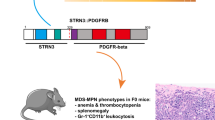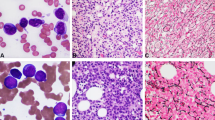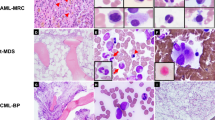Abstract
The mixed lineage leukemia gene (MLL, also known as HRX, ALL-1 and Htrx) located at 11q23 is involved in translocations with over 40 different chromosomal bands in a variety of leukemia subtypes. Here we report our analysis of a rare but recurring translocation, t(11;15)(q23;q14). This translocation has been described in a small subset of cases with both acute myeloblastic leukemia and ALL. Recent studies have shown that MLL is fused to AF15q14 in the t(11;15). Here we analyse a sample from another patient with this translocation and confirm the presence of an MLL–AF15q14 fusion. However, we have also identified and cloned another fusion transcript from the same patient sample. In this fusion transcript, MLL is fused to a novel gene, MLL partner containing FYVE domain (MPFYVE). Both MLL–AF15q14 and MLL–MPFYVE are in-frame fusion transcripts with the potential to code for novel fusion proteins. MPFYVE is also located on chromosome 15, approximately 170 kb telomeric to AF15q14. MPFYVE contains a highly conserved motif, the FYVE domain which, in other proteins, has been shown to bind to phosphotidyl-inositol-3 phosphate (PtdIns(3)P). The MLL–MPFYVE fusion may be functionally important in the leukemia process in at least some patients containing this translocation.
This is a preview of subscription content, access via your institution
Access options
Subscribe to this journal
Receive 50 print issues and online access
$259.00 per year
only $5.18 per issue
Buy this article
- Purchase on Springer Link
- Instant access to full article PDF
Prices may be subject to local taxes which are calculated during checkout







Similar content being viewed by others
Accession codes
References
Adams MD, Kelley JM, Gocayne JD, Dubnick, M, Polymeropoulos MH, Xiao H, Merril CR, Wu A, Olde B and Moreno RF . (1991). Science, 252, 1651–1656.
Ayton PM and Cleary ML . (2001). Oncogene, 20, 5695–5707.
Bernard OA and Berger R . (1995). Genes Chromosomes Cancer, 13, 75–85.
Breen TR and Harte PJ . (1993). Development, 117, 119–134.
Burd CG and Emr SD . (1998). Mol. Cell, 2, 157–162.
Caldas C, So CW, MacGregor A, Ford AM, McDonald B, Chan LC and Wiedemann LM . (1998). Gene, 208, 167–176.
DiMartino JF and Cleary ML . (1999). Brit. J. Hematol., 106, 614–626.
Divoky V, Trka JM, Watzinger F and Lion T . (2000). Gene, 247, 111–118.
Gaullier JM, Simonsen A, D'Arrigo A, Bremnes B, Aasland R and Stenmark H . (1998). Nature, 394, 432–433.
Gibbons B, Katz FE, Ganly P and Chessells JM . (1990). Br. J. Heamatol., 74, 264–269.
Gu Y, Nakamura T, Alder H, Prasad R, Canaani O, Cimino G, Croce CM and Canaani E . (1992). Cell, 71, 701–708.
Hanson RD, Hess JL, Yu BD, Ernst P, van Lohuizen M, Berns A, van der Lugt NM, Shashikant Ch, Ruddle FH, Seto M and Korsmeyer SJ . (1999). Proc Natl. Acad. Sci., 96, 14372–14377.
Hayette S, Tigaud I, Vanier A, Martel S, Corbo L, Charrin C, Beillard E, Deleage G, Magaud JP and Rimokh R . (2000). Oncogene, 19, 4446–4450.
Hernandez JM, Mecucci C, Beverloo HB, Selleri L, Wlodarska I, Stul M, Michaux L, Verhoof G, Van Orshoven A and Gassiman JJ . (1995). Leukemia, 9, 1162–1166.
Hillion J, Le Coniat M, Jonveaux P, Berger R and Bernard O . (1997). Blood, 90, 3714–3719.
Hunger SP, Tkachuk DC, Amylon MD, Link MP, Carroll AJ, Welborn JL, Willman CL and Cleary ML . (1993). Blood, 81, 3197–3203.
Kaneko Y, Shikano T, Maseki N, Sakurai M, Sakurai M, Takeda T, Hiyoshi Y, Mimaya J and Fujimoto T . (1988). Leukemia, 2, 672–676.
Kuefer MU, Behm FG, Naeve CW, Rakestraw KM, Raimondi SC and Morris SW . (1997). Blood, 90 (Suppl 1), 1235.
Lavau C, Du C, Thirman M and Zeleznik-Le N . (2000a) EMBO J., 19, 4655–4664.
Lavau C, Luo RT, Du C and Thirman MJ (2000b) Proc. Natl. Acad. Sci., 97, 10984–10989.
Lavau C, Szilvassy SJ, Slany R and Cleary ML . (1997). EMBO J., 16, 4226–4237.
Martinez-Climent JA, Thirman MJ, Espinosa III R, Le Beau MM and Rowley JD . (1995). Leukemia, 9, 1299–1304.
Nilson I, Lochner K, Siegler G, Greil J, Beck JD, Fey GH and Marschalek R . (1996). Br. J. Haematol., 93, 966–972.
Nucifora G, Begy CR, Kobayashi H, Roulston D, Claxton D, Pedersen-Bjergaard J, Parganas E, Ihle JN and Rowley JD . (1994). Proc. Natl. Acad. Sci., 91, 4004–4008.
Patki V, Lawe DC, Corvers S, Virbasius JV and Chawla A . (1998). Nature, 394, 433–434.
Raimondi SC, Peiper SC, Kitchingman GR, Behm FG, Williams DL, Hancock ML and Mirro J Jr. (1989). Blood, 73, 1627–1634.
Rowley JD . (1993) Seminars in Cancer Biology, ed. Rabbitts, T. H. (Academic, London). Semin. Cancer Biol., 4, 377–385.
Rowley JD (1999). Semin. Hematol., 36 (Suppl 7), 59–72.
Rubnitz JE, Link MP, Shuster JJ, Carroll AJ, Hakani N, Frankel LS, Pullen DJ and Cleary ML . (1994). Blood, 84, 570–573.
Schwabe JWR and Klug A . (1994). Nature Struct. Biol., 1, 345–349.
Stenmark H and Aasland R . (1999). J. Cell Sci., 112, 4175–4183.
Stenmark H, Aasland R, Toh BH and D'Arrigo A . (1996). J. Biol. Chem., 271, 24048–24054.
Tkachuk DC, Kohler S and Cleary ML (1992). Cell, 71, 691–700.
Thirman MJ, Gill HJ, Burnett RC, Mbangkollo D, McCabe NR, Kobayashi H, Ziemin-van der Poel S, Kaneko Y, Morgan R, Sandberg AA, Chaganti RSK, Larson RA, Le Beau MM, Diaz MO and Rowley JD . (1993). N. Engl. J. Med., 329, 909–914.
Waring PM and Cleary ML (1997). Curr. Top. Microbiol. Immunol., 220, 1–23.
Whitman SP, Strout MP, Marcucci G, Freud AG, Culley LL, Zeleznik-Le NJ, Mrozek K, Theil KS, Kees UR, Bloomfield CD and Caligiuri MA . (2001). Cancer Res., 61, 59–63.
Yu BD, Hess JL, Horning SE, Brown GA and Korsmeyer SJ . (1995). Nature, 378, 505–508.
Zeleznik-Le NJ, Harden AM and Rowley JD . (1994). Proc. Natl. Acad. Sci., 91, 10610–10614.
Acknowledgements
We thank Dr Steve Morris and Dr Martin Kuefer for sharing sequence information of AF15q14 and the preliminary data about the size and the expression pattern of AF15q14 prior to publication.This study was supported by grants CA 42557 and CA 84405 (J.D.R.); CA40046 and CA78438 (N.J.Z.-L.); a postdoctoral fellowship award from Leukemia Research Foundation and Cancer Biology training grant, T32 CA09595 (VC) and by the Spastic Paralysis Foundation of Illinois, Eastern Iowa District of Kiwanis International.
Author information
Authors and Affiliations
Corresponding author
Rights and permissions
About this article
Cite this article
Chinwalla, V., Chien, A., Odero, M. et al. A t(11;15) fuses MLL to two different genes, AF15q14 and a novel gene MPFYVE on chromosome 15. Oncogene 22, 1400–1410 (2003). https://doi.org/10.1038/sj.onc.1206273
Received:
Revised:
Accepted:
Published:
Issue Date:
DOI: https://doi.org/10.1038/sj.onc.1206273
Keywords
This article is cited by
-
ANCHR mediates Aurora-B-dependent abscission checkpoint control through retention of VPS4
Nature Cell Biology (2014)
-
A novel spliced fusion of MLL with CT45A2in a pediatric biphenotypic acute leukemia
BMC Cancer (2010)
-
Spliced MLL fusions: a novel mechanism to generate functional chimeric MLL-MLLT1 transcripts in t(11;19)(q23;p13.3) leukemia
Leukemia (2007)
-
SEPT2 is a new fusion partner of MLL in acute myeloid leukemia with t(2;11)(q37;q23)
Oncogene (2006)
-
The MYO1F, unconventional myosin type 1F, gene is fused to MLL in infant acute monocytic leukemia with a complex translocation involving chromosomes 7, 11, 19 and 22
Oncogene (2005)



